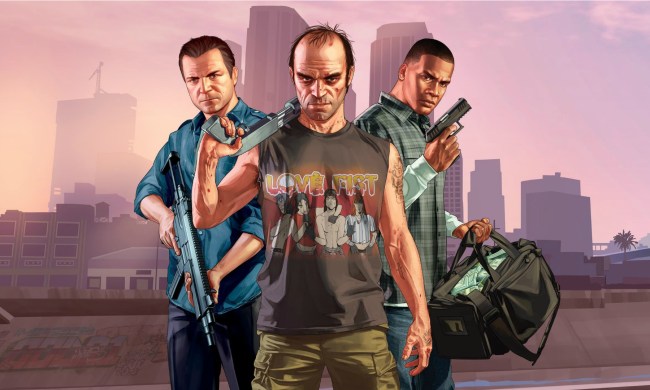Tapping into the increasingly popular trend of in-game photography-as-real life art is Québécois artist Benoit Paillé, who has garnered considerable interest for his Grand Theft Auto V-related CROSSROAD OF REALITIES project, featured recently in a post on Rockstar Games’ Newswire blog. Rather than relying on the in-game camera, Paillé uses his IRL DSLR to snap scenic images off the screen from around Los Santos. He touches these up in Lightroom as he would with other real world photographs, then uses the images as backgrounds for studio shoots in which actual human arms jut up into the frame, holding up various kinds of cameras.
The overall effect is of looking at a photo-within-a-photo that is lit and arranged to make it appear as if an actual human is inside the game taking pictures. Paillé elaborates on his process in this documentary.
The striking, cumulative effect of this skilled image-manipulation is to blur the border between the physical and virtual spaces that we inhabit. In the artist’s own words: “The photographic performance of this project is to overlay a material reality with a virtual one, erasing the border between the two worlds. It is a response to the proliferation of visual projects that take place in virtual spaces. It is a questioning about the notion of border and territory. A mix of two distinct realities into a single image. I want to show that we can use a virtual space in conceptual photography and approach these areas with the same sensitivity as the physical space.”
Gamers have long found ways to utilize video game engines for their own creative projects, with machinima films tracing their roots back to Quake in the mid-90’s. However, recent technological leaps in graphics towards photorealistic fidelity have led to a recent rash of interest in recording static images. This exploded in popularity with heavily-modded screen captures from Bethesda Softworks’ Skyrim, and has since become a well-documented among GTA V players, as seen on the GTA Adventures subreddit.
Paillé’s work stands out, though, for its mixture of physical and simulated photography, capturing something more subtle and playful about the way gamers engage with their virtual spaces. True to his French roots, the artist starts his project by quoting media philosopher Jean Baudrillard’s seminal 1981 “Simulacra and Simulation,” which has shown itself to be an eerily prescient mediation on the ever-fuzzier distinction between reality and the imagined worlds we increasingly inhabit in the 21st century: “A simulacra is an object that does not refer to any underlying reality, but claims to be this reality itself.”


